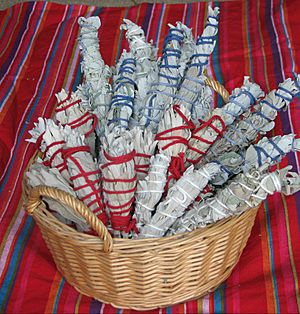Smudging facts for kids
Smudging is a special ceremony practiced by some Indigenous peoples in North and South America. It involves burning sacred herbs, like white sage, or tree resins. People use the smoke for spiritual cleansing or to bless places and people.
It's important to know that different Indigenous groups have their own unique ways of doing these ceremonies. The herbs they use, the reasons for burning them, and what they call the practice can be very different. Elders, who are respected community leaders, guide these ceremonies and share their cultural knowledge.
Sometimes, people outside Indigenous communities have started using smudging practices for things like New Age beliefs or selling products. This is called cultural appropriation. It can lead to problems like too many plants being picked from nature, which is called over-harvesting. Indigenous people in the US and Canada have spoken out against these issues.
Contents
Indigenous Traditions in North America
In many Indigenous and First Nations ceremonies, specific herbs are used. These herbs help to purify or bless people and places. For example, some cultures burn red cedar smoke. They use it for healing and purification ceremonies.
However, an herb that is sacred to one culture might not be used by another. It might even be used for a totally different reason. When herbs are burned in a ceremony, it might not always be called "smudging." This depends on the specific culture.
Gathering Herbs for Ceremonies
Traditionally, people are very careful when gathering herbs for ceremonies. They think about the best time to collect them. This could be at dawn or evening. It might also depend on the moon's phases or yearly cycles. For example, a Lumbee elder named Gertrude Allen shared that her father, who was a plant expert, knew that sage's power changes throughout the year.
The Use of Sage
While sage is often linked with smudging, its use is not universal. Many Native American, First Nations, Inuit, or Métis cultures use types of sage found in their areas. But not all Indigenous groups use sage for purification.
The widespread use of sage in some areas is often due to the Pan-Indian movement. This movement brought together different Indigenous traditions. Sometimes, using sage can even go against what is traditional for a certain region. Also, not all Indigenous cultures that burn herbs call it "smudging."
Smoke in Spiritual Practices
Many cultures around the world use scents and smoke in their spiritual practices. Think of incense in different religions. But the specific details, reasons, and spiritual meanings are usually unique. They belong to the culture that practices them.
Smoke Use in Other Cultures
Other cultures worldwide also burn herbs or incense for spiritual reasons. Examples include smoking ceremonies in Australia. Some forms of saining in Scotland also use smoke. People might also use censers to burn incense.
However, these cultures have their own unique practices. They also have their own beliefs about these actions. The spiritual meaning of smoke is special to each culture.


